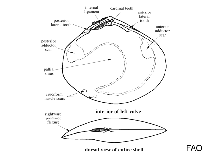Abra nitida (Müller, 1776)
Warning: DOMDocument::load(): SSL operation failed with code 1. OpenSSL Error messages: error:140770FC:SSL routines:SSL23_GET_SERVER_HELLO:unknown protocol in C:\Apache24\htdocs\includes\SpeciesSummary.lib.php on line 1236
Warning: DOMDocument::load(): Failed to enable crypto in C:\Apache24\htdocs\includes\SpeciesSummary.lib.php on line 1236
Warning: DOMDocument::load(https://sealifebase.nrm.se/webservice/AquaMaps/getAMap.php?genus=Abra&species=nitida): failed to open stream: operation failed in C:\Apache24\htdocs\includes\SpeciesSummary.lib.php on line 1236
Warning: DOMDocument::load(): I/O warning : failed to load external entity "https://sealifebase.nrm.se/webservice/AquaMaps/getAMap.php?genus=Abra&species=nitida" in C:\Apache24\htdocs\includes\SpeciesSummary.lib.php on line 1236
Uploaden van je Foto's
Google afbeelding | No image available for this species;
drawing shows typical species in Semelidae.
Google afbeelding | No image available for this species;
drawing shows typical species in Semelidae.
Classification / Names Common names | Synonyms | CoL | ITIS | WoRMS
| Cardiida | Semelidae
Environment: milieu / climate zone / depth range / distribution range Ecologie
; diepteverspreiding 24 - 4400 m (Ref. 123853). Temperate; 71°N - 31°N, 11°W - 29°E
Verspreiding Landen | FAO regio's | Ecosystems | Voorkomen | Introducties
Eastern Atlantic and the Mediterranean: from Morocco to northern Norway, and east to Romania.
Length at first maturity / Size / Gewicht / Leeftijd
Maturity: Lm ? range ? - ? cmMaximaal vermelde leeftijd: 2.00 jaren (Ref. 2823)
A surface deposit feeder (Ref. 96501). Found offshore at 80 m depth (Ref. 2823). Mainly found in muddy sediments but also lives in fine sand (Ref. 123853). Main food and feeding type based on another species of the same genus; to be replaced with a better reference (Ref. 88171).
Life cycle and mating behavior Geslachtsrijpheid | Voortplanting | Kuitschieten | Eieren | Fecundity | Larven
Members of the class Bivalvia are mostly gonochoric, some are protandric hermaphrodites. Life cycle: Embryos develop into free-swimming trocophore larvae, succeeded by the bivalve veliger, resembling a miniature clam.
Voornaamste referentie
Referenties | Coördinator | Medewerkers
López-Jamar, E., G. González and J. Mejuto. 1986. (Ref. 2778)
Status op de Rode Lijst van het IUCN (Ref. 130435)
Status bij CITES (Ref. 108899)
Not Evaluated
CMS (Ref. 116361)
Not Evaluated
Gevaarlijk voor mensen
Gebruik door de mens
| FishSource |
Tools
Meer informatie
Populaire namen
Synoniemen
Predators
Voortplanting
Geslachtsrijpheid
Kuitschieten
Fecundity
Eieren
Ontwikkeling van de eieren
Synoniemen
Predators
Voortplanting
Geslachtsrijpheid
Kuitschieten
Fecundity
Eieren
Ontwikkeling van de eieren
Internet-bronnen
BHL | BOLD Systems | CISTI | DiscoverLife | FAO(Publication : search) | Fishipedia | GenBank (genoom, nucleotide) | GloBI | Gomexsi | Google Books | Google Scholar | Google | PubMed | Tree of Life | Wikipedia (ga naar, zoek) | Zoological Record
Estimates based on models
Prijsklasse
(Ref. 80766):
Unknown.



